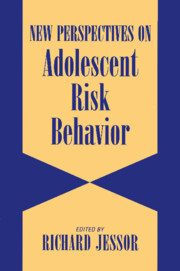Book contents
- Frontmatter
- Contents
- List of contributors
- Preface
- 1 New perspectives on adolescent risk behavior
- Part I A focus on development
- Part II A focus on problem behavior
- Part III A focus on sexual activity
- Part IV A focus on psychopathology
- Part V A focus on social role performance
- 11 Transition to adulthood among high-risk youth
- 12 Disengagement from school and problem behavior in adolescence: A developmental-contextual analysis of the influences of family and part-time work
- 13 New perspectives on adolescent work and the transition to adulthood
- Part VI Overview and integration
- Author index
- Subject index
11 - Transition to adulthood among high-risk youth
Published online by Cambridge University Press: 06 July 2010
- Frontmatter
- Contents
- List of contributors
- Preface
- 1 New perspectives on adolescent risk behavior
- Part I A focus on development
- Part II A focus on problem behavior
- Part III A focus on sexual activity
- Part IV A focus on psychopathology
- Part V A focus on social role performance
- 11 Transition to adulthood among high-risk youth
- 12 Disengagement from school and problem behavior in adolescence: A developmental-contextual analysis of the influences of family and part-time work
- 13 New perspectives on adolescent work and the transition to adulthood
- Part VI Overview and integration
- Author index
- Subject index
Summary
Introduction
A recent report by the National Research Council (1993) on high-risk adolescents concludes that research should focus on those who are most at risk for not making a successful transition to young adulthood, that is, those who grow up in poor communities, attend underfunded schools, and live in families that lack the social and economic resources to support their children's socialization process appropriately. In addition, the panel specifically suggested that research should move beyond the sole emphasis on measuring youth problems (such as drug use, pregnancy, arrest) and accomplishments (graduation, employment) to include assessment of the individual and community attributes (alienation, responsibility, attachment, emotional health) that underlie the “status” outcomes (p. 248).
The conceptual issues and empirical results that we present in this chapter are organized around childhood and adolescent social role performance and psychological well-being, which seem to lead to successful adult role performance among a cohort of inner-city children. As Jessor (1993) states, the field of adolescence has been invigorated by a more comprehensive theory, more attention to development, increased awareness of the importance of biology and genetics on the one hand and the social and cultural contexts on the other, a more inclusive focus on previously ignored populations of adolescents, notably ethnic minorities and those living in poverty, and a broader range of research and statistical methods. We attempt to reflect these trends and to address heir implications for future research and program development.
- Type
- Chapter
- Information
- New Perspectives on Adolescent Risk Behavior , pp. 364 - 390Publisher: Cambridge University PressPrint publication year: 1998
- 6
- Cited by

